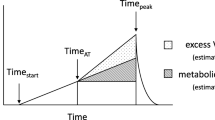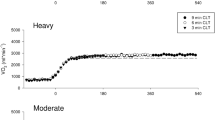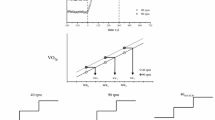Abstract
This study systematically examined the role of work rate (WR) increment on the kinetics of pulmonary oxygen uptake (VO2p) and near-infrared spectroscopy (NIRS)-derived muscle deoxygenation (Δ[HHb]) during moderate-intensity (Mod) cycling. Fourteen males (24 ± 5 years) each completed four to eight repetitions of Mod transitions from 20 to 50, 70, 90, 110 and 130 W. VO2p and Δ[HHb] responses were modelled as a mono-exponential; responses were then scaled to a relative % of the respective response (0–100 %). The Δ[HHb]/VO2 ratio was calculated as the average Δ[HHb]/VO2 during the 20–120 s period of the on-transient. When considered as a single group, neither the phase II VO2p time constant (τVO2p; 27 ± 9, 26 ± 11, 25 ± 10, 27 ± 14, 29 ± 13 s for 50–130 W transitions, respectively) nor the Δ[HHb]/VO2 ratio (1.04 ± 0.13, 1.10 ± 0.13, 1.08 ± 0.07, 1.09 ± 0.11, 1.09 ± 0.09, respectively) was affected by WR (p > 0.05); yet, the VO2 functional gain (G; ΔVO2/ΔWR) increased with increasing WR transitions (8.6 ± 1.3, 9.1 ± 1.2, 9.5 ± 1.0, 9.5 ± 1.0, 9.9 ± 1.0 mL min−1 W−1; p < 0.05). When subjects were stratified into two groups [Fast (n = 6), τVO2p130W < 25 s < τVO2p130W, Slower (n = 8)], a group by WR interaction was observed for τVO2p. The increasing functional G persisted (p < 0.05) and did not differ between groups (p > 0.05). The Δ[HHb]/VO2 ratio was smaller (p < 0.05) in the Fast than Slower group, but was unaffected by WR. In conclusion, the present study demonstrated (1) a non-uniform effect of Mod WR increment on τVO2p; (2) that τVO2p in the Slower group is likely determined by an O2 delivery limitation; and (3) that increasing Mod WR increments elicits an increased functional G, regardless of the τVO2p response.





Similar content being viewed by others
References
Babcock MA, Paterson DH, Cunningham DA, Dickinson JR (1994) Exercise on-transient gas exchange kinetics are slowed as a function of age. Med Sci Sports Exerc 26:440–446
Beaver WL, Lamarra N, Wasserman K (1981) Breath-by-breath measurement of true alveolar gas exchange. J Appl Physiol 51:1662–1675
Beaver WL, Wasserman K, Whipp BJ (1986) A new method for detecting anaerobic threshold by gas exchange. J Appl Physiol 60:2020–2027
Bell C, Paterson DH, Kowalchuk JM, Padilla J, Cunningham DA (2001) A comparison of modelling techniques used to characterise oxygen uptake kinetics during the on-transient of exercise. Exp Physiol 86:667–676
Bowen WJ (1949) The absorption spectra and extinction coefficients of myoglobin. J Biol Chem 179:235–245
Bowen TS, Murgatroyd SR, Cannon DT, Cuff TJ, Lainey AF, Marjerrison AD, Spencer MD, Benson AP, Paterson DH, Kowalchuk JM, Rossiter HB (2011) A raised metabolic rate slows pulmonary O2 uptake kinetics on transition to moderate-intensity exercise in humans independently of work rate. Exp Physiol 96:1049–1061
Bowen TS, Cannon DT, Murgatroyd SR, Birch KM, Witte KK, Rossiter HB (2012) The intramuscular contribution to the slow oxygen uptake kinetics during exercise in chronic heart failure is related to the severity of the condition. J Appl Physiol 112:378–387
Brittain CJ, Rossiter HB, Kowalchuk JM, Whipp BJ (2001) Effect of prior metabolic rate on the kinetics of oxygen uptake during moderate-intensity exercise. Eur J Appl Physiol 86:125–134
DeLorey DS, Kowalchuk JM, Paterson DH (2003) Relationship between pulmonary O2 uptake kinetics and muscle deoxygenation during moderate-intensity exercise. J Appl Physiol 95:113–120
duManoir GR, DeLorey DS, Kowalchuk JM, Paterson DH (2010) Kinetics of VO2 limb blood flow and regional muscle deoxygenation in young adults during moderate intensity, knee-extension exercise. Eur J Appl Physiol 108:607–617
Ferrari M, Muthalib M, Quaresima V (2011) The use of near-infrared spectroscopy in understanding skeletal muscle physiology: recent developments. Philos Transact A Math Phys Eng Sci 369:4577–4590
Glancy B, Barstow T, Willis WT (2008) Linear relation between time constant of oxygen uptake kinetics, total creatine, and mitochondrial content in vitro. Am J Physiol Cell Physiol 294:C79–C87
Grassi B, Poole DC, Richardson RS, Knight DR, Erickson BK, Wagner PD (1996) Muscle O2 uptake kinetics in humans: implications for metabolic control. J Appl Physiol 80:988–998
Griffiths TL, Henson LC, Whipp BJ (1986) Influence of inspired oxygen concentration on the dynamics of the exercise hyperpnoea in man. J Physiol 380:387–403
Hughson RL, Morrissey M (1982) Delayed kinetics of respiratory gas exchange in the transition from prior exercise. J Appl Physiol 52:921–929
Kalliokoski KK, Scheede-Bergdahl C, Kjaer M, Boushel R (2006) Muscle perfusion and metabolic heterogeneity: insights from noninvasive imaging techniques. Exerc Sport Sci Rev 34:164–170
Kemp G (2008) Physiological implications of linear kinetics of mitochondrial respiration in vitro. Am J Physiol Cell Physiol 295:C844–C846 (author reply C847–C848)
Kemps HM, Schep G, Zonderland ML, Thijssen EJ, De Vries WR, Wessels B, Doevendans PA, Wijn PF (2010) Are oxygen uptake kinetics in chronic heart failure limited by oxygen delivery or oxygen utilization? Int J Cardiol 142:138–144
Lamarra N, Whipp BJ, Ward SA, Wasserman K (1987) Effect of interbreath fluctuations on characterizing exercise gas exchange kinetics. J Appl Physiol 62:2003–2012
Linnarsson D (1974) Dynamics of pulmonary gas exchange and heart rate changes at start and end of exercise. Acta Physiol Scand Suppl 415:1–68
MacPhee SL, Shoemaker JK, Paterson DH, Kowalchuk JM (2005) Kinetics of O2 uptake, leg blood flow, and muscle deoxygenation are slowed in the upper compared with lower region of the moderate-intensity exercise domain. J Appl Physiol 99:1822–1834
Murias JM, Kowalchuk JM, Paterson DH (2010) Speeding of VO2 kinetics with endurance training in old and young men is associated with improved matching of local O2 delivery to muscle O2 utilization. J Appl Physiol 108:913–922
Murias JM, Kowalchuk JM, Paterson DH (2011a) Speeding of VO2 kinetics in response to endurance-training in older and young women. Eur J Appl Physiol 111:235–243
Murias JM, Spencer MD, Delorey DS, Gurd BJ, Kowalchuk JM, Paterson DH (2011b) Speeding of VO2 kinetics during moderate-intensity exercise subsequent to heavy-intensity exercise is associated with improved local O2 distribution. J Appl Physiol 111:1410–1415
Murias JM, Spencer MD, Kowalchuk JM, Paterson DH (2011c) Influence of phase I duration on phase II VO2 kinetics parameter estimates in older and young adults. Am J Physiol Regul Integr Comp Physiol 301:R218–R224
Murias JM, Spencer MD, Kowalchuk JM, Paterson DH (2011d) Muscle deoxygenation to VO2 relationship differs in young subjects with varying τVO2. Eur J Appl Physiol 111:3107–3118
Paterson DH, Whipp BJ (1991) Asymmetries of oxygen uptake transients at the on- and offset of heavy exercise in humans. J Physiol 443:575–586
Puente-Maestu L, Sanz ML, Sanz P, Nunez A, Gonzalez F, Whipp BJ (2001) Reproducibility of the parameters of the on-transient cardiopulmonary responses during moderate exercise in patients with chronic obstructive pulmonary disease. Eur J Appl Physiol 85:434–441
Scheuermann BW, Barstow TJ (2003) O2 uptake kinetics during exercise at peak O2 uptake. J Appl Physiol 95:2014–2022
Spencer MD, Murias JM, Kowalchuk JM, Paterson DH (2011a) Pulmonary O2 uptake and muscle deoxygenation kinetics are slowed in the upper compared with lower region of the moderate-intensity exercise domain in older men. Eur J Appl Physiol 111:2139–2148
Spencer MD, Murias JM, Lamb HP, Kowalchuk JM, Paterson DH (2011b) Are the parameters of VO2, heart rate and muscle deoxygenation kinetics affected by serial moderate-intensity exercise transitions in a single day? Eur J Appl Physiol 111:591–600
Spencer MD, Murias JM, Grey TM, Paterson DH (2012) Regulation of VO2 kinetics by O2 delivery: insights from acute hypoxia and heavy-intensity priming exercise in young men. J Appl Physiol 112:1023–1032
Whipp BJ (1971) Rate constant for the kinetics of oxygen uptake during light exercise. J Appl Physiol 30:261–263
Whipp BJ, Wasserman K (1972) Oxygen uptake kinetics for various intensities of constant-load work. J Appl Physiol 33:351–356
Whipp BJ, Ward SA, Wasserman K (1986) Respiratory markers of the anaerobic threshold. Adv Cardiol 35:47–64
Wilkerson DP, Koppo K, Barstow TJ, Jones AM (2004) Effect of work rate on the functional ‘gain’ of phase II pulmonary O2 uptake response to exercise. Respir Physiol Neurobiol 142:211–223
Acknowledgments
We would like to express our gratitude to the subjects in this study and to acknowledge the technical assistance provided by Brad Hansen.
Grants
This study was supported by Natural Sciences and Engineering Research Council of Canada (NSERC) research and equipment grants. M. D. Spencer was supported by an Ontario Graduate Scholarship (OGS).
Author information
Authors and Affiliations
Corresponding author
Additional information
Communicated by David C. Poole.
Rights and permissions
About this article
Cite this article
Spencer, M.D., Murias, J.M., Kowalchuk, J.M. et al. Effect of moderate-intensity work rate increment on phase II τVO2, functional gain and Δ[HHb]. Eur J Appl Physiol 113, 545–557 (2013). https://doi.org/10.1007/s00421-012-2460-3
Received:
Accepted:
Published:
Issue Date:
DOI: https://doi.org/10.1007/s00421-012-2460-3




